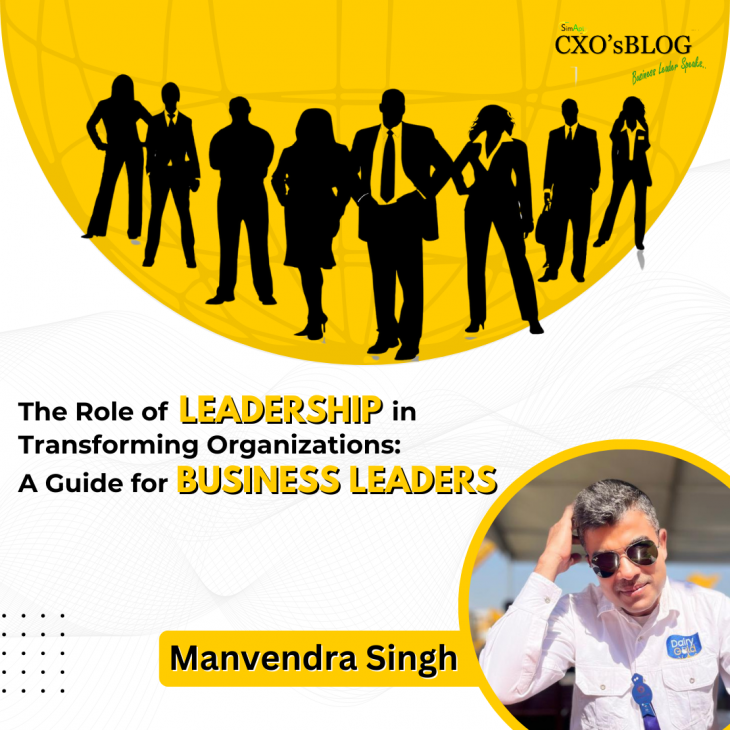Author: Manvendra Singh
In the fast-changing world of business today, leadership is perhaps turning out to be the single most critical element. Effective leadership is the foundation upon which transformation is carried and upon which sustainable growth depends for organizations as they navigate through the complexities and vagaries of the world. Over 25 years of hands-on experience in companies within industries as distinct as FMCG, dairy foods, alcoholic and non-alcoholic beverages, and tobacco have taught me that leadership is far more than managing people. It is more about building the desired change, promoting innovative solutions with the optimum use of scarce resources, and creating resilient organizations. Leadership comes from within what you believe in can only be translated into action and once that’s sorted you can inculcate in others and cascade the same
Visionary Leadership: Setting Course to Transformation
Any effective leadership commences with a vision a clear and compelling description of the future through which an organization will set its strategic direction. As a leader, it is critical to have the capability to develop and communicate a vision that is consistent with market demand and organizational capability. This vision has to ground but ambitious enough so that the organization goes out of its comfort zone.
As someone who has been in global giants such as Danone and Philip Morris for over a decade, I find the most successful transformations are the ones in which leadership was able to clearly translate the company’s vision into concrete, actionable strategies. These strategies are not only limited to long-term goals but ensure that every team member has clear and distinct roles in the achievement of these objectives. A shared vision brings purpose and unity that should drive collective effort toward transformation.
Agility and Adaptability: Navigating Through Change
The business world keeps changing constantly. Those changes are driven by technological advancements, market dynamics, and shifts in consumer behaviour. Thus, the leader must be agile and adaptive while preparing strategies for a pivot whenever necessary to be steps ahead. Agility is all about being proactive rather than reactive, anticipating the change and setting the organization to go on its way to respond proactively.
In my previous role at Lactalis, one of the world’s largest dairy groups, the challenge was to sustain traditional business models while finding new paths to growth and development. It has been walking on a tightrope to balance operational efficiency with innovative product lines, like those offered under the President brand. On that account, I would repeat that the leadership should be a blend data-driven decisions and strategies fine-tuned all the time based on real-time feedback from the field.
Empowering Teams: The Heart of Organizational Transformation
A leader can never drive transformation alone; it is the cumulative effort of empowered teams that breathes life into the vision. So, as leaders, we need to create an environment where our people feel valued, trusted, and motivated to give their 100%. This calls not just for delegation but for mentorship and coaching, as well as the creation of a culture of learning.
At Dairy Gold, where we operate in a completely different culture within Sub-Saharan Africa, the maxim that people are what matter has grown manifolds. We have been able to navigate market volatility and effect tremendous growth in this region by investing in the very people of the region through creating an environment of transparency and risk taking ability, communication, and equipping them with the right tools. All this leads to making empowered teams more robust, innovative, and committed and therefore becomes the leading force behind every successful transformation.
Strategic Thinking: How to Balance Short-term Wins with Long-term Goals
Transformation is a process, not a one-off event. For the executive, it requires a strategic equilibrium between meeting short-term objectives and preparing for the future. A good leader is able to balance the sojourn through immediate challenges with staying focused on the ultimate goal. This strategic contemplation involves understanding the trends in the market, understanding what customers’ needs are, understanding what the competitive landscape is all about, and aligning organizational resources in ways that benefit from the opportunities.
My experience throughout international markets, but specifically in those of high-growth regions such as Asia-Pacific and Africa, has also been a huge learning school of how strategic foresight is really key to success. Establishment of a new market presence and opening a new greenfield project completely works on a well-thought-out strategy considering the current ground reality and future possibilities.
Making Change Happen: The Power Of True Leadership
Finally, the best leaders have adopted the belief in leading by example. Authentic leadership entails the principle of actions speaking louder than words and helps in gathering trust and credibility, both within the organization and externally. It is all about showing integrity, accountability, and a true commitment to the vision and values of a person’s organization.
From my experiences, I have learned how a leader can be impactful and change an organization, its people, and the values it holds in high regard. When a leader lives the values he espouses by example, other people want to live up to the same practices, setting up this incredible culture of becoming great together.
Leadership is the catalyst for organizational transformation. This is more than just steering the ship; this is pointing in the right direction, empowering the crew, and leading through an ever-changing sea with agility and foresight. We owe it to the teams we lead to inspire and guide changes that enable our organizations not only to survive but to prosper in an ever-changing world. With visionary leadership, strategic thinking, and authentic engagement, the necessary changes can be driven to create sustainable, profitable futures for our businesses.
